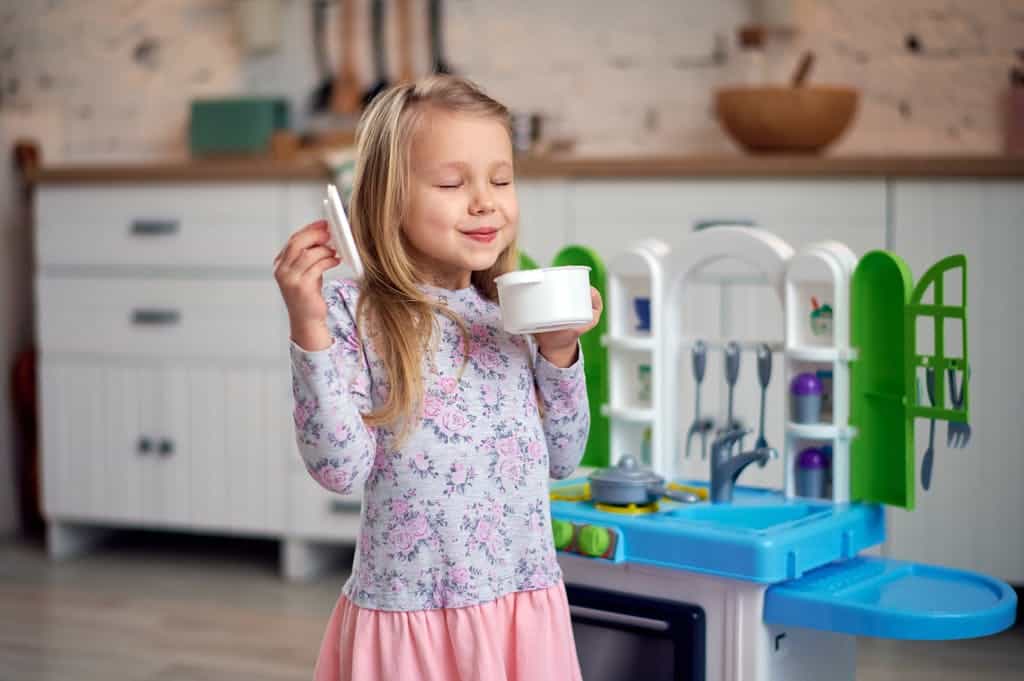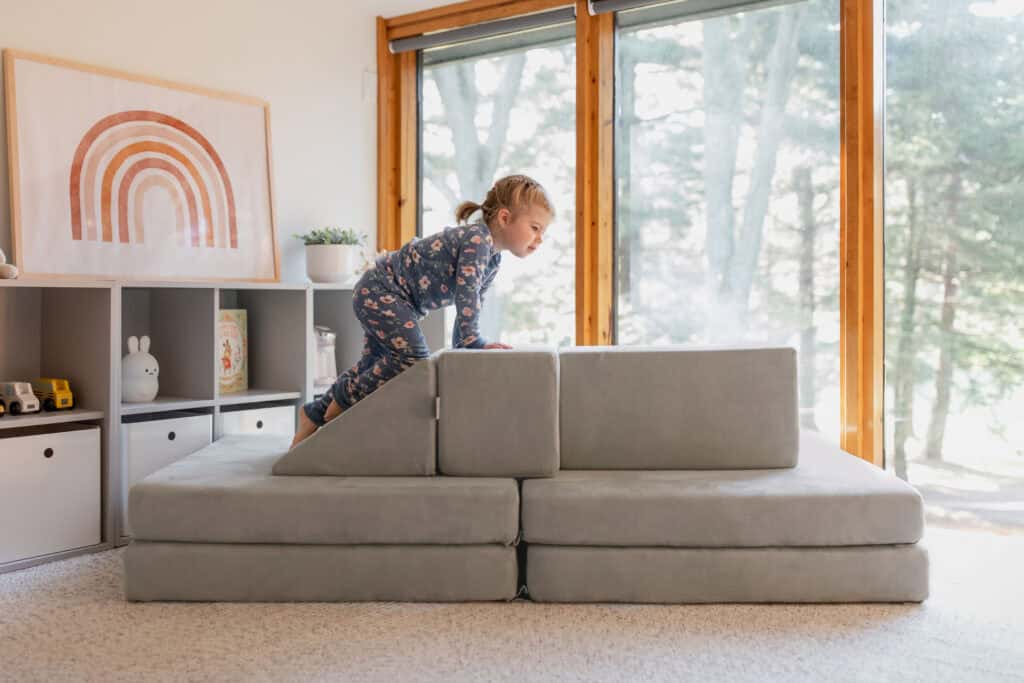5 Living Room Playroom Combo Ideas for a Functional and Playful Home
If you’ve ever found yourself stepping over a trail of toy cars, dodging LEGO bricks, or wondering if your living room will ever feel like a calm, inviting space again, you’re not alone. Many parents dream of a clutter-free living room but also want to provide their children with space to play, explore, and learn. Here are five creative ways to design a living room-playroom combo that blends functionality, style, and play.

Play. Learn. Thrive.™ only endorses products we authentically love and use. Some of the product links in this post may be affiliate links. That means that if you click them and make a purchase, this site makes a commission. Play. Learn. Thrive.™ is also an Amazon Associate. As an Amazon Associate, we earn from qualifying purchases. It will have no impact on the price you pay or the experience of your purchase.
The good news? You don’t need a separate playroom to make it work. With some intentional design and smart organization, you can create a living room that supports both adult relaxation and child-led play—without feeling like a toy store exploded in the middle of your home.

1. Create a Play-Friendly Storage System
One of the biggest challenges of a shared living-play space is keeping it organized. Toys have a magical way of multiplying, and without a proper system, they can quickly take over every available surface. Instead of resigning yourself to a cluttered floor, invest in storage solutions that make cleanup easy while maintaining the aesthetic of your home.
Smart Storage Ideas for a Play-Friendly Living Room
✔ Ottomans with hidden storage – Store stuffed animals, puzzles, or craft supplies inside and use them as extra seating.
✔ Coffee tables with drawers or storage baskets underneath – Perfect for quick clean-up when guests arrive.
✔ Bench seating with storage underneath – A cozy reading spot that also hides toys.
✔ Woven or fabric bins – Blend seamlessly with your decor while keeping blocks, dolls, or action figures contained.
✔ Rolling carts – Ideal for art supplies, LEGO, or board games that can be moved around as needed.
✔ Wall-mounted shelves – Keep books, baskets, and small toys off the floor while making the most of vertical space.
👉 Why it works: Having a designated place for toys makes it easier for kids to help with cleanup, reducing daily chaos and keeping your space functional for everyone.

50 Simple Screen-Free Learning Activities for Curious Kids
These 50 hands-on activities help children develop problem-solving skills, creativity, and real-world knowledge—without needing a screen. Designed to encourage self-directed play, hands-on discovery, and deep learning, this guide gives you a simple way to turn everyday moments into powerful learning opportunities.
2. Designate a Play Corner (Without Sacrificing Style)
You don’t need to turn your entire living room into a playroom. A simple, well-defined play area can give kids a special space for creativity while keeping the rest of the room open for family activities.
How to Set Up a Play Corner That Blends with Your Home
✔ Use a low Montessori-style shelf – Display a small selection of toys for easy access and better engagement.
✔ Lay down a play rug or mat – Visually define the space while adding comfort and warmth.
✔ Create a cozy reading nook – A small bookshelf, bean bag, or soft floor cushions encourage quiet, independent time.
✔ Use stylish storage bins – Keep everything organized without disrupting your living room aesthetic.
👉 Why it works: When kids have a clear, inviting space, they are naturally drawn to it, encouraging independent play while leaving the rest of the living room free for family time.

3. Incorporate Active Play Elements
Kids don’t just sit and play—they love to climb, jump, and move! Instead of constantly saying “No running in the house!” create a space that allows for safe, indoor movement.
Ways to Add Movement to a Shared Living Space
✔ A foldable Pikler triangle – Great for climbing and can be tucked away when not in use.
✔ A balance board – Helps with coordination and doubles as a stylish piece of decor.
✔ An indoor swing or hanging hammock chair – A playful, sensory-friendly element that also looks chic.
✔ A small foam play couch – Kids can use it for fort-building, tumbling, or just lounging.
✔ Jumping stones or stepping logs – Encourage balance and imaginative play without taking up much space.
👉 Why it works: When kids have built-in ways to move, they burn off energy without resorting to screens—leading to calmer afternoons and better sleep at night.
4. Choose Playful Yet Stylish Decor
A living room doesn’t have to scream “playroom,” but small decor choices can make the space feel just as inviting for children as it does for adults.
How to Make Your Living Room Playful Yet Grown-Up
✔ Opt for neutral storage solutions – Wicker baskets, white shelves, and wooden toy organizers keep the space looking stylish.
✔ Frame kids’ artwork – Displaying their creations in beautiful frames makes the space feel intentional and personal.
✔ Use wall decals or chalkboard paint – A fun way to encourage creativity without adding clutter.
✔ Incorporate interactive decor – A sensory wall, magnetic board, or low-hanging art station can keep little hands busy.
✔ Choose soft, kid-friendly textiles – A plush area rug or oversized floor cushions make the space cozy and functional for all ages.
👉 Why it works: By thoughtfully incorporating kid-friendly elements into your decor, you create a family-friendly space that still feels like your home—not a daycare.

Figgy Play Couch = Must Have for Kids!
We adore our Figgy Play Couch because it is WASHABLE and DURABLE! It is a lot sturdier than other play couches out there and for us, the washable feature is what sold it! All of our kids love it and play with it every single day.
5. Make Cleanup Quick & Kid-Friendly
A well-organized space won’t stay that way unless kids can help maintain it. The key is to make cleanup simple, routine, and even fun.
Kid-Friendly Cleanup Hacks
✔ Use color-coded bins – Assign each type of toy a color-coded bin to make sorting easier.
✔ Set a 5-minute cleanup timer – Make it a game to see how much can be cleaned before the buzzer.
✔ Create a “Toy Library” system – Keep some toys stored away and rotate them in and out to prevent clutter.
✔ Use labeled picture bins – Especially helpful for younger kids who can’t read yet.
✔ Establish a daily reset routine – Tidy up as a family before dinner or bedtime.
👉 Why it works: When kids know exactly where things go, they’re more likely to clean up on their own, making your living room a stress-free space for the whole family.
Creating a living room-playroom combo doesn’t mean giving up a beautifully designed space—it just means being more intentional with how you use it. By incorporating smart storage, playful yet stylish decor, and movement-friendly elements, you can design a home that nurtures both family connection and child-led play.




